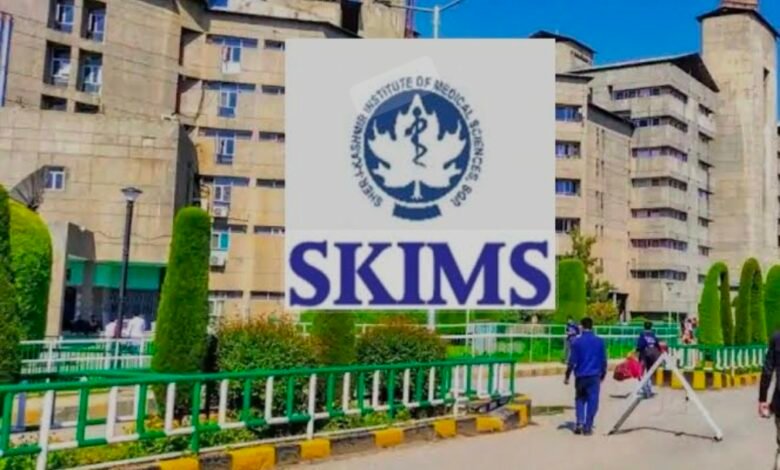When Leadership Falters, Institutions Suffer: A Case Study of SKIMS’ Past Mismanagement and Present Revival

Srinagar, April 6, : The adage, “When the gardener sleeps, weeds take over the orchard,” finds stark relevance when examining the tenure of the previous head of Sher-i-Kashmir Institute of Medical Sciences (SKIMS), Soura. The legacy of that leadership, marked by isolation and inaction, came under intense scrutiny during the recent session of the Jammu and Kashmir Legislative Assembly, where members deliberated extensively on the issue of underutilization of funds.
SKIMS, envisioned as a centre of excellence in healthcare, has made headlines for all the wrong reasons during the financial years 2022–23 and 2023–24. Once hailed as North India’s leading tertiary care institution after AIIMS, its reputation suffered due to lapses in financial planning and healthcare management.
While SKIMS continues to serve a massive population with services comparable to those offered by PGI Chandigarh and AIIMS Delhi, its record of fiscal discipline during recent years presents a concerning contrast—highlighting a tale of mismanagement on one side and potential for excellence on the other.
Strategically located in the heart of Jammu and Kashmir, SKIMS remains a cornerstone of advanced medical care and education, catering to nearly 10,000 to 20,000 individuals daily. Despite this enormous responsibility, the institute’s financial operations over the past three years paint a troubling picture of inefficiency and lost opportunities.
Under the previous administration, approximately Rs 90 crore of allocated funds were either left unused or entangled in bureaucratic stagnation. In 2021–22 alone, Rs 34.16 crore—roughly a third of the total budget—remained unspent. The trend continued in 2022–23, with Rs 21.72 crore going unused. The following year, 2023–24, saw an additional Rs 34.22 crore lapse. These failures resulted in deteriorating infrastructure, halted procurement processes, and a severe impact on patient care.
There were widespread allegations of collusion between certain officials and contractors, with suspicions of misappropriation looming large. Essential medicines, such as Paracetamol and Phenytoin Sodium 100mg—critical for seizure disorder patients—remained unavailable in the hospital for nearly two years, further underlining systemic failure. Tragically, this negligence cost lives—not due to a lack of resources, but because of mismanagement of existing ones. An institution founded to save lives, even amid financial hardship, had become a victim of the very malaise it was meant to fight.
However, there appears to be a shift under the current leadership. The financial year 2024–25 marks a significant turnaround. Unlike the previous administration, the present team has demonstrated commitment, transparency, and fiscal responsibility. Of the Rs 79 crore allocated for the year, the entirety has been utilized for infrastructure development and modernization. A major highlight is the procurement of a Rs 29 crore state-of-the-art linear accelerator under the SCI grant, which significantly enhances the institute’s cancer treatment capabilities.
This transformation symbolizes a new beginning—an active repudiation of past inefficiencies and a bold assertion that change is possible with dedication and accountability.
In contrast, PGIMER Chandigarh continues to exemplify unwavering financial discipline. Its 2021–22 budget stood at Rs 2,200 crore, a 3.6% increase from Rs 2,123 crore in 2022–23. Of this, Rs 343.10 crore was allocated to capital assets—an amount that eclipses the total annual budget of SKIMS. The upward trend persisted in 2024–25, with Rs 350 crore earmarked for infrastructure and medical advancements, reinforcing PGIMER’s commitment to excellence.
The disparity between the two institutions is glaring. PGIMER thrives under sustained governmental support and efficient administration, while SKIMS has struggled under the weight of neglect. Nonetheless, SKIMS’ recent achievements reflect its potential for resurgence. Past failures should not be used as justification to withhold future investments. Instead, they should serve as a powerful reminder of the urgent need for enhanced oversight, robust planning, and adequate funding.
With the current administration achieving complete budget utilization in the last two quarters, SKIMS stands at a critical juncture. Though scars from the past remain, they must not define its future. Increasing and strategically deploying the budget is not only a logistical necessity but also a moral obligation. Healthcare is not an expenditure—it is an investment in the well-being and dignity of society.
The recent progress at SKIMS must be consolidated and sustained. One successful year does not erase the history of inefficiency. Strengthening procurement systems, ensuring transparency, and upholding financial integrity will be crucial in maintaining momentum. Under its current leadership, SKIMS has the opportunity to set new benchmarks in healthcare delivery—not only in Jammu and Kashmir but across North India.
SKIMS’ journey—from decline to revival—underscores the intricate relationship between governance, funding, and healthcare delivery. Its evolution will undoubtedly influence the future of tertiary healthcare in India. However, this revival cannot be the responsibility of the institution alone. The government must step in—not necessarily with PGIMER-level funding, but with sufficient support to remove bottlenecks and allow SKIMS to flourish and gain national recognition.
The era of skepticism must end. It is now time for decisive, sustained action.





